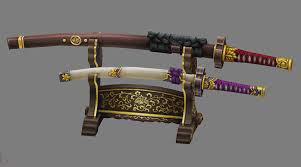The history of the katana
The katana, a quintessential symbol of Japanese craftsmanship and martial prowess, has a history deeply intertwined with the samurai warrior class and the evolution of Japanese swordsmanship. Originating from ancient Japan, the katana's legacy spans centuries, marked by technological advancements, cultural shifts, and the rise and fall of empires.
The term "samurai sword" often encompasses various blades wielded by the samurai, including the iconic katana. As the embodiment of the samurai's code of bushido, the katana symbolizes honor, loyalty, and discipline.
The history of the katana traces back to the Heian period (794–1185), where swords were primarily straight and double-edged. However, it was during the Kamakura period (1185–1333) that the precursor to the katana, known as the tachi, gained prominence. Worn edge-downward, the tachi served as a weapon of choice for mounted samurai, reflecting the warfare tactics of the time.
The evolution of the katana continued into the Muromachi period (1336–1573), characterized by innovations in swordsmithing techniques and the refinement of blade curvature. This period saw the emergence of the uchigatana, a versatile sword worn edge-upward and favored by foot soldiers and infantry.
The true katana as we recognize it today flourished during the Momoyama period (1573–1603) and reached its peak during the Edo period (1603–1868). Master swordsmiths perfected the art of crafting katana blades using traditional methods such as differential hardening and folding, resulting in swords of exceptional sharpness, strength, and beauty.
The katana's significance extended beyond its practical use in combat, becoming a symbol of the samurai's status, honor, and spiritual connection to their ancestors. The sword's curvature, balance, and cutting ability reflected the samurai's skill and dedication to the martial arts.
The concept of the "blue katana" invokes imagery of mystique and elegance. While traditional katana blades were often adorned with intricate hamon patterns and polished to a brilliant shine, the term "blue katana" may refer to swords with a distinct bluish hue resulting from unique steel compositions or specialized heat treatments.
In modern times, the katana continues to captivate enthusiasts worldwide, both as a symbol of Japan's rich cultural heritage and as a functional weapon in martial arts practice. Whether displayed in museums, wielded by practitioners, or featured in popular media, the katana's legacy endures as a testament to the samurai's indomitable spirit and the timeless artistry of Japanese swordsmiths.

